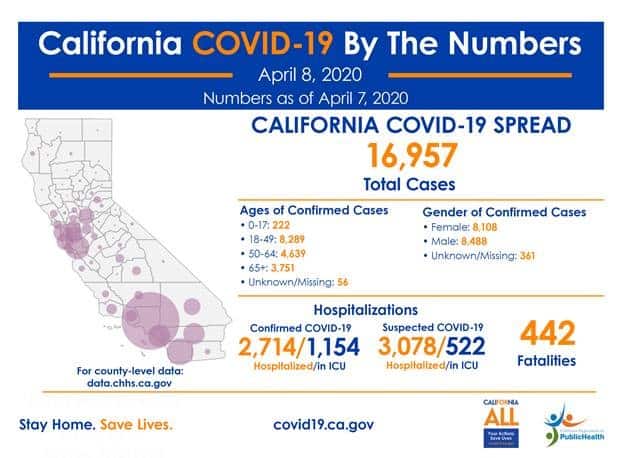SACRAMENTO – The California Department of Public Health today announced the most recent statistics on COVID-19. California now has 16,957 confirmed cases and 442 deaths. Starting today, racial demographics of COVID-19 cases and deaths, along with expanded data on infection rates of healthcare workers, will be available.
Racial Demographics
CDPH is releasing race and ethnicity data related to COVID-19. This initial information, representing 37 percent of COVID-19 cases and 39 percent of deaths, shows the race and ethnicity data is roughly in line with the diversity of California overall:
- Latinos: 30% of cases and 29% of deaths (39% of the state’s population)
- Whites: 37% of cases and 43% of deaths (37% of the state’s population)
- African Americans/Blacks: 6% of cases and 3% of deaths (6% of the state’s population)
- Asians: 14% of cases and 16% of deaths (15% of the state’s population)
- Multiracial: 2.5% of cases and 2% of deaths (2% of the state’s population)
- American Indians or Alaska Natives: 0.2% of cases and 0.6% of deaths (0.5% of the states’ population)
- Native Hawaiians or Pacific Islanders: 1.6% of cases and 1% of deaths (0.3% of the state’s population)
- Other: 9% of cases and 5% of deaths (N/A)
Health Care Workers
As of April 7, local health departments have reported 1,651 confirmed positive cases in health care workers. CDPH had previously only reported health care worker infections among workers who had a confirmed case that was acquired while on the job. Since COVID-19 is moving rapidly within the community, health care workers now appear just as likely, if not more so, to become infected by COVID-19 outside the workplace. As such, CDPH is now reporting the number of health care workers overall who are affected, regardless of where they were exposed.
This larger number, which includes both occupational and non-occupational exposures, is important because it shows the overall impact of COVID-19 on the healthcare workforce. Regardless of the source of exposure, an infected health care worker needs to isolate from the workforce to prevent risk of infection to colleagues and the patients they serve.
CDPH is working closely with local health departments to present that larger number, which includes non-workplace exposures, such as travel or through family. To date, California has:
- 299 health care workers who acquired COVID-19 in a health care setting
- 462 health care workers who have been exposed via travel, close contacts, or community transmission
- 890 health care workers whose specific exposure source has not been reported
As testing capacity ramps up, and more tests are being conducted directly in physician’s offices and processed through commercial laboratories, local public health officials will not be able to report the source of exposure for every affected health care worker. From today going forward, we will release the larger number of health care workers affected by COVID-19.
Testing in California
As of April 7, approximately 168,800 tests had been conducted in California. At least 154,733 results have been received and another 14,100 are pending. These numbers include data California has received from commercial, private and academic labs, including Quest, LabCorp, Kaiser, University of California and Stanford, and the 22 state and county health labs currently testing.

How People Can Protect Themselves
Every person has a role to play. Protecting yourself and your family comes down to common sense:
- Staying home except for essential needs/activities.
- Practicing social distancing.
- Washing hands with soap and water for a minimum of 20 seconds.
- Avoiding touching eyes, nose or mouth with unwashed hands.
- Covering a cough or sneeze with your sleeve, or disposable tissue. Wash your hands afterward.
- Avoiding close contact with people who are sick.
- Staying away from work, school or other people if you become sick with respiratory symptoms like fever and cough.
- Following guidance from public health officials.
What to Do if You Think You’re Sick
Call ahead: If you are experiencing symptoms of COVID-19 (fever, cough or shortness of breath) and may have had contact with a person with COVID-19, or recently traveled to countries with apparent community spread, call your health care provider before seeking medical care so that appropriate precautions can be taken.
For more information on COVID-19 and California’s response visit the California Department of Public Health website.
More information about what Californians can do to prevent the spread of COVID-19 is available at www.covid19.ca.gov.
California continues to issue guidance on preparing and protecting California from COVID-19. Consolidated guidance is available at www.cdph.ca.gov/covid19guidance.
###


You guys are doing a great job!
When is unemployment going to be available to sole proprietors and independent contractors? Governor announcing these are available but i have applied and been denied because I am not eligible ….